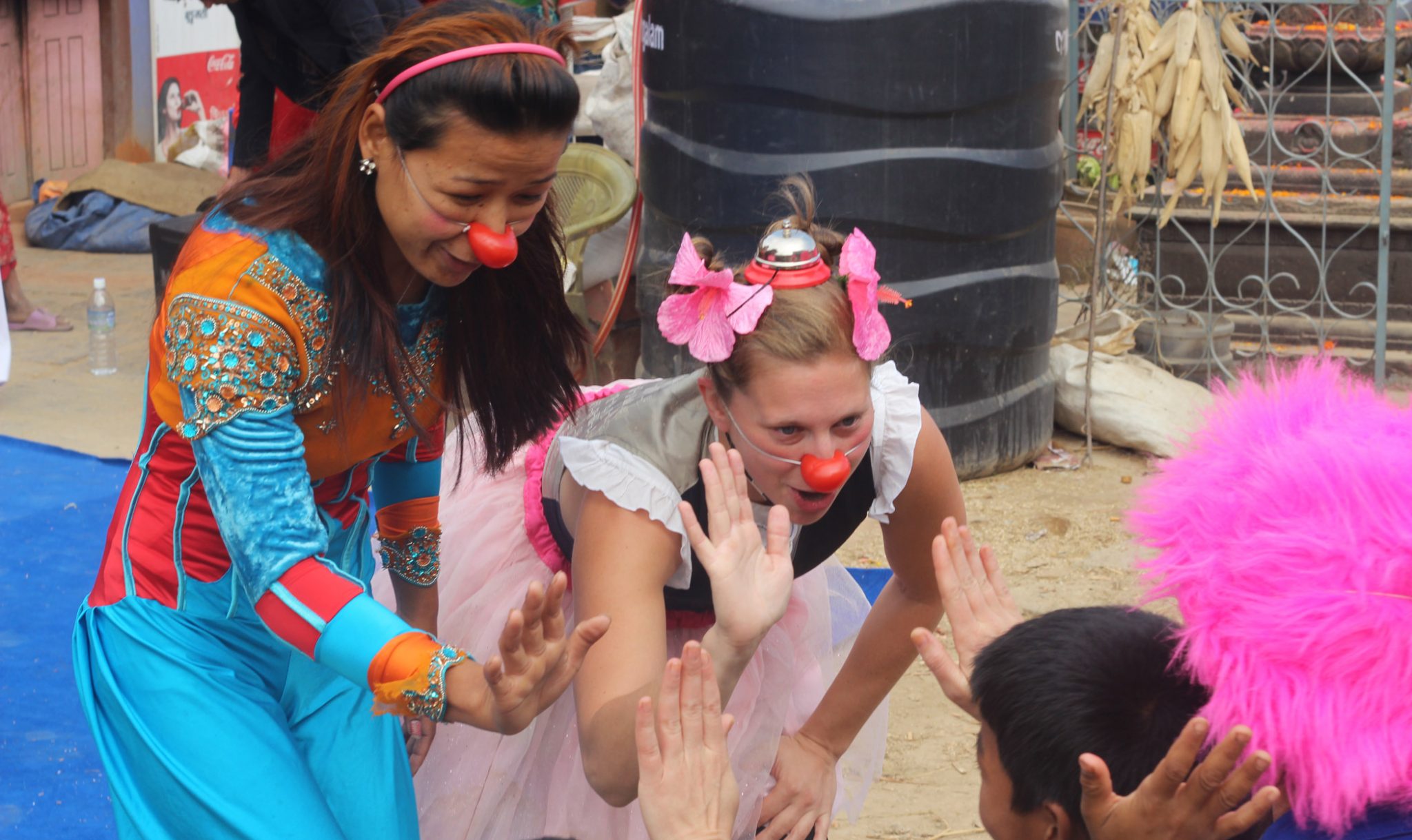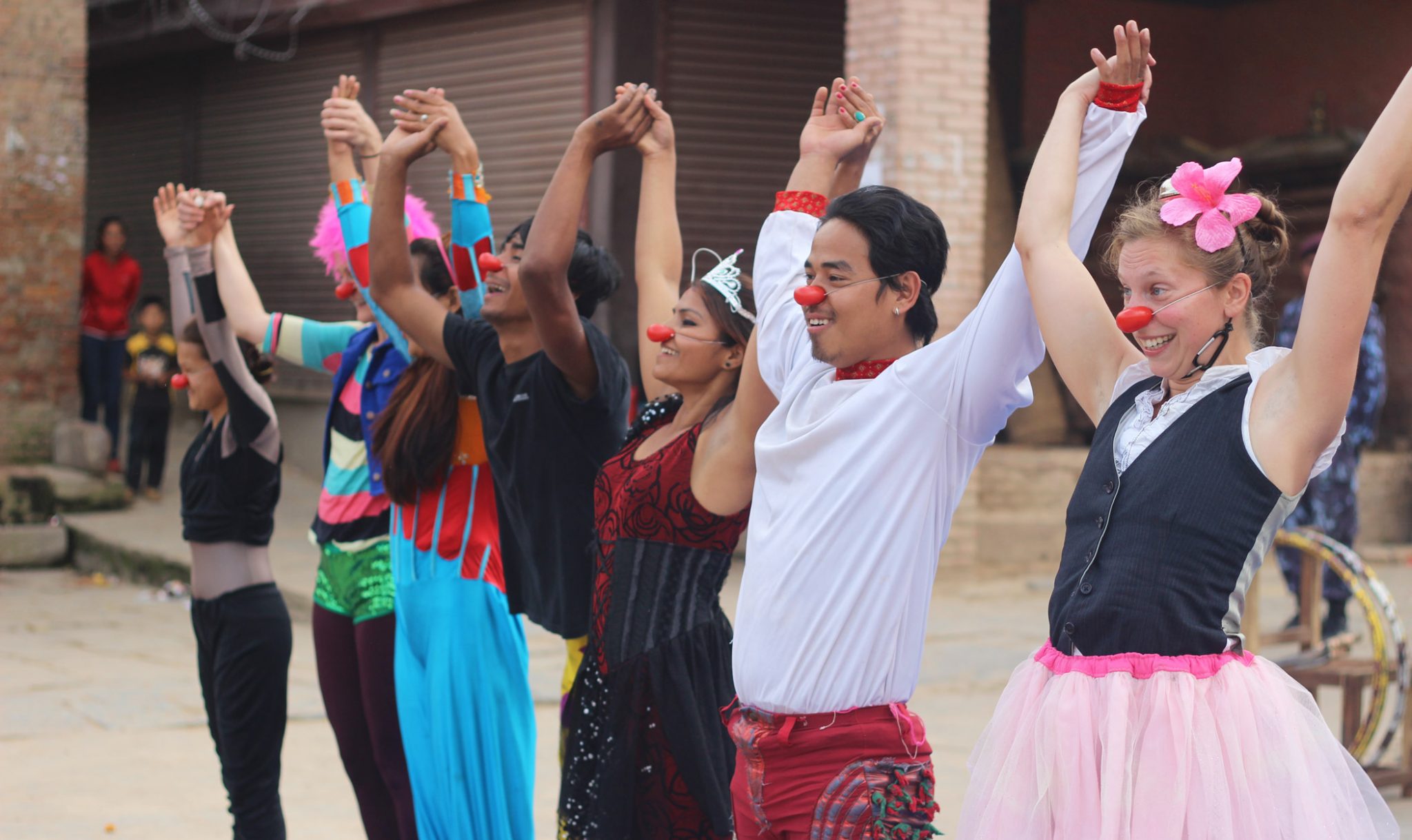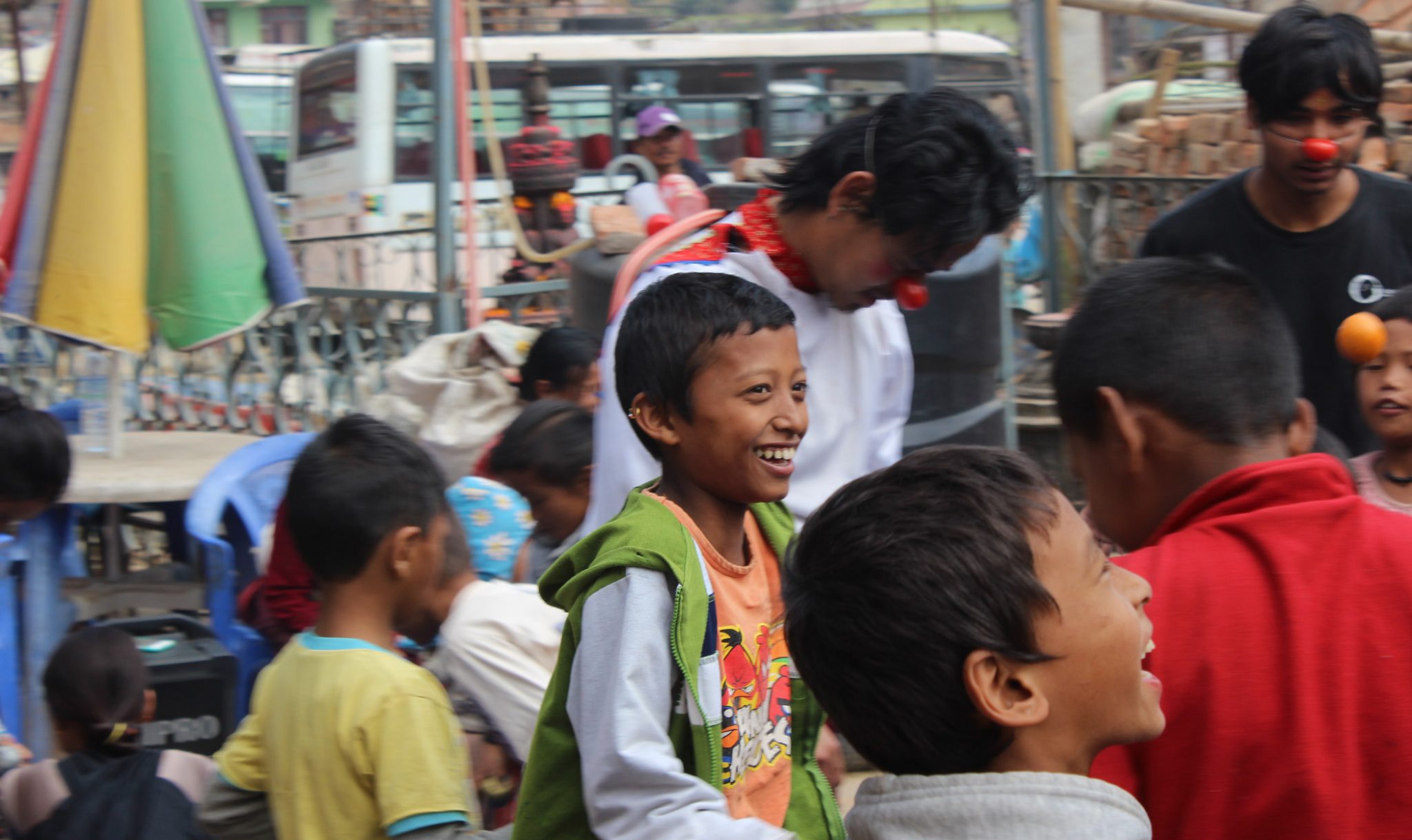Healing with laughter
The street is dusty and lined with rubble, swept into orderly piles. Across the road, half of a five-storey building stands out conspicuously, its bright pink wallpaper and zig-zagging stairs giving the impression of peering into a dismembered doll’s house. Groups of men and women sit on the sidewalk opposite, some playing card games, others chatting. A few have noticed the curious blue carpet that has been rolled out, and are waiting with anticipation as to what, if anything, will happen.
Music begins to play. And soon, an unexpected figure emerges. She has pink hair, green hotpants and an unmistakeable clown nose. Then another one appears, in a multi-coloured jumpsuit, sporting the same red nose. At first, the children are wary of the strange figures who are not quite adult, definitely not children, but so eager to play and so childishly fascinated by everything they see. Then a small boy with a green hoodie and a mischievous grin jumps off the swing and runs over to them. Within minutes, there is a Pied Piper effect and a large crowd of children has gathered. The adults begin to draw closer too, looking bewilderedly at the group of seven clowns who now grace the blue carpet stage, dancing, inviting the audience to laugh with them, to be silly and just have fun.
Before the earthquake, the historic village of Bungamati was one of the prettiest parts of the Kathmandu valley, frequently visited by tourists who would come to see the ancient temples and monuments. Since the earthquake last April, most of the visitors have been aid groups or volunteers, and now, the remains of half-destroyed buildings and crumbling temples are evidence that reconstruction is still a long way off. But on this sunny day, a group of people have arrived who definitely don’t want to talk about the earthquake. It’s the result of a unique collaboration between Circus Kathmandu and Clowns Without Borders, two organisations who both use theatre and play as a means to overcome trauma. And increasingly, people in the humanitarian sector are beginning to realise the unique value of the performing arts in bringing relief to people in a time of disaster.
“After a tragedy, people are so traumatised and so busy with figuring out practical things like where they’re going to sleep, that they forget to laugh,” says Micael Bogar, who has a background in conflict resolution and applied theatre and has been a volunteer with Clowns Without Borders since 2009. The international ‘humanitarian clowning’ movement has chapters in 12 countries and has sent teams to perform in places such as the refugee camps of Lesbos, Greece, and the evacuation centres of post-Typhoon Philippines (Bogar was part of that group), in partnership with local and international NGOs.

Jamuna Tamang and Juliana Frick greet the crowd of children who have cautiously gathered to watch the clowns’ performance. “There’s usually a warm up where they’re checking us out and getting comfortable. By the end it’s awesome, it’s crazy,” says Frick.
Bogar and her teammate Juliana Frick, both from San Francisco, came to Nepal after being invited to take part in a two-week tour of earthquake-affected areas by Circus Kathmandu, the country’s first professional circus group. Founded by filmmaker and circus artist Sky Neal in 2010 as a programme to provide support for children who had been trafficked into Indian circuses, Circus Kathmandu is now made up of 13 young people who are using their skills to forge sustainable careers, performing professionally in Nepal and internationally. They also conduct regular outreach work with street children and, more recently, earthquake survivors. After Bungamati, which is a mere 20-minute drive from Circus Kathmandu’s training centre in Jhamsikhel, the team—comprising the two Americans and six members of Circus Kathmandu—would be travelling further afield to more isolated Himalayan communities, such as the village of Ghyachchok, which lies close to the epicentre of the earthquake in the Gorkha district.
It’s not the first time Circus Kathmandu has visited Ghyachchok. In June 2015, the troupe embarked on a four-day trip to Gorkha as part of an outreach project called ‘Artworks’, which involved dancers, artists and educators. The group began by performing for the primary school children at the village, followed by a circus skills activity session.
“At first, the girls didn’t want to touch the boys and vice versa. But we mixed them all in one group and played games,” says Jamuna Tamang, who joined Circus Kathmandu five years ago after being trafficked into an Indian circus as a teenager. “By the second day, they felt free and they were running all over the place. We didn’t provide anything material to them but we gave them self-confidence and motivation,” she says.
In the context of a disaster, circus and clowning fall under the category of psychosocial relief, a way of helping survivors to deal with the emotional impact of what they’ve been through by using joy and laughter. Niranjan Kunwar, a writer and education consultant who led the Artworks outreach project, believes that for young children this can be more effective than dwelling too much on the cause of the trauma. “I happen to think they just need a normal schedule after what they’ve been through,” he says. “Talking too much about the earthquake may not be helpful.”
Teams of Artworks volunteers have so far made three trips to earthquake-hit rural villages—isolated, neglected communities whose problems have only been exacerbated by the disaster. Kunwar’s aim is to use art, in all its forms, to plant the seeds of inspiration. “We’re showing them certain things. As an educator I believe that once you spark someone’s imagination, many things could happen,” he says.

After Bungamati, the group travelled to isolated rural communities in Dolakha and Gorkha districts, including the village of Ghyachchok, which lies close to the epicentre of the April earthquake.
Bogar is more frank about clowning’s specific role in post-disaster contexts. “Laughter is a healing, powerful thing,” she says. “The simple reminder of ‘Hey, we’re all still here. The sun is shining.’ It’s delicate to come in and say that to someone, but it’s really important!”
Bogar, however, is clear that this kind of relief only has a place after essential needs have been met. “We have this philosophy that humanitarian clowning is amazing, but it doesn’t bring you food and shelter and medical aid, and those are the first things that need to happen,” she says. “We don’t go into places that haven’t had this initial support.”
In Bungamati, by the end of the short performance (which involves a queen, three thieves, a magical crown and some impressive acrobatics), the previously shy and cautious children have been well and truly won over. Jumping and laughing, they swarm the stage, and a sense of delight pervades the air in this usually quiet street: a small piece of magic in an unlikely setting.

